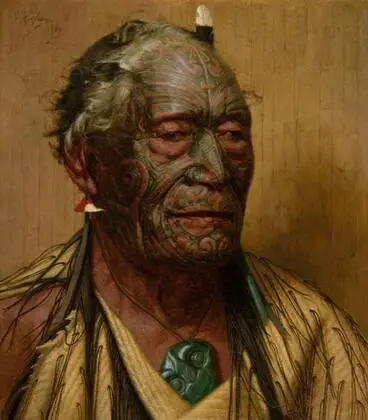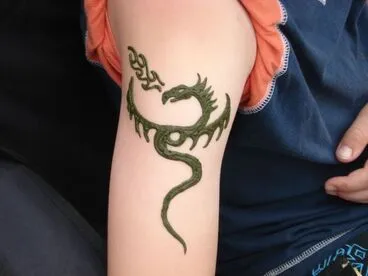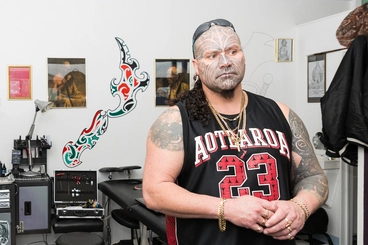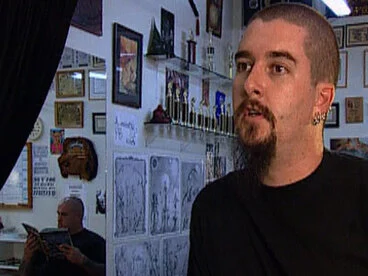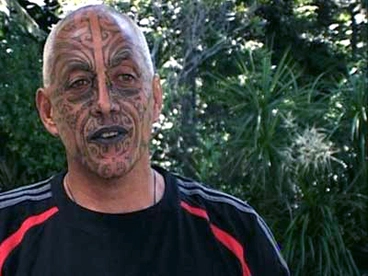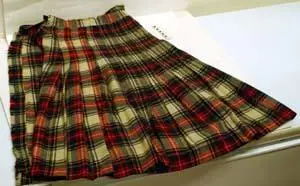Cross-Cultural Identity: Tuia Mātauranga Curiosity Card
A DigitalNZ Story by National Library Services to Schools
The curiosity card depicts a tattoo combining Māori kōwhaiwhai design with Scottish tartan patterns. The image below shows kilt-clad and tattooed participants at the Turakina Highland Games in 2006. – possibly of both Māori and Scots descent.
Tattoos and kilts
Manatū Taonga, the Ministry for Culture and Heritage
BACKGROUND
Tattooing is common throughout the Pacific Islands. In New Zealand, Māori developed techniques to cut deeply into the skin, producing grooved scars. The spiral motifs are distinctively Māori. Moko originated in rituals of mourning for the dead. Women would haehae (cut) themselves with shells or obsidian and put soot in the wounds.
In tradition, tā moko was brought from the underworld by a chief called Mataora, who married a tūrehu (spirit) called Niwareka. She fled to the underworld after he hit her. He followed and was taught tā moko techniques by her father, Uetonga.
Kei ngā takiwā puta noa i Te Moananui-a-Kiwa kitea ai te tā moko. Ka whanake te mātauranga ki te haehae hōhonu i te kiri, kia hua ai ngā rauru, arā, he whakairo tūturu nā te Māori ake. I ahu mai te tā moko i ngā whakamomori i te hunga mate. Ka haehae te wahine i tōna kiri ki te mata angaanga, mata tūhua rānei.
Kātahi ka pania ngā awa ki te pungarehu. E ai ki te kōrero, i ahu mai te whakairo i te rangatira, i a Mataora. I moe tūrehu a Mataora, ko Niwareka te ingoa. Nō tōna tūkino i tāna wahine i a Niwareka; ka hoki ia ki tōna kāinga i Rarohenga. Ka whai atu a Mataora i a ia, ā, ka akona iho ki te tā moko e tōna hungarei, e Uetonga.
Tattoos
Tattoos have become increasingly common over the last 20 years especially in New Zealand, which now has one of the highest percentages of tattooed people in the world. That’s not surprising given our Polynesian heritage; the art of tattooing first originated in Polynesia.
For many New Zealanders, tattoos define and represent their identity. They express their wearer’s passions, history, family ties, and cultural background.
One type of tattoo unique to New Zealand/Aotearoa is the kirituhi – literally writing on skin. These tattoos are not traditional tā moko (tattoos designed and worn by Māori only) but are inspired by or incorporate Māori or Polynesian designs. They are often created by or made for someone from a non-Māori culture.
Visually kirituhi can often tell us where someone is from (like Aotearoa) and also who they identify with (their whakapapa or ancestry). For example, this curiosity card shows a kirituhi tattoo proclaiming the wearer’s multicultural Scottish and Māori ancestry. Both cultures are strikingly revealed through a clever mix of two distinct cultural symbols; the Māori kōwhaiwhai pattern and the Scottish tartan.
Tattoos say something about who we are. They represent a form of visual storytelling because they reveal our individual and collective identities.
History and origins
'Tā moko – Māori tattooing', URL: http://www.teara.govt.nz/en/ta-moko-maori-tattooing, (Ministry for Culture and Heritage), (published 5-September-2013)
Ngā pūtakenga
'Tā moko', URL: http://www.teara.govt.nz/mi/ta-moko, (Ministry for Culture and Heritage), (published 5-September-2013)
Moko
DigitalNZ
Genealogy of Māui and Porourangi
Manatū Taonga, the Ministry for Culture and Heritage
Warrior receiving moko (colour proof print of Lindauer painting "Tohunga ta moko at work", 1915)
Museum of New Zealand Te Papa Tongarewa
Uhi ta moko (tattooing instrument)
Museum of New Zealand Te Papa Tongarewa
Tattooing Pigment in shell
Museum of New Zealand Te Papa Tongarewa
Te Rauparaha’s moko
Manatū Taonga, the Ministry for Culture and Heritage
John Rutherford, the tattooed Englishman
Manatū Taonga, the Ministry for Culture and Heritage
QUICK FACTS
- Tattooing was a common cultural practice across Polynesia before Europeans arrived.
- The English word tattoo is based on the Tahitian word tatu which means to mark.
- It was Sir Joseph Banks, who first recorded the word tattoo in his journal on Captain Cook’s 1769 expedition.
- Moko refers to traditional Māori tattooing. To wear a moko means both the recipient and tattooer have Māori whakapapa.
- Moko represents your mana. It is a way of confirming and celebrating your whakapapa, identity and history.
- A tohunga tā moko is an expert in tattooing moko. Often they will have a background in Māori carving and a deep knowledge of Māori visual language and symbolism.
- A kirituhi is a cross-cultural tattoo. Māori imagery is used but it is often created by or made for someone from a non-Māori culture.
- Kiri means ‘skin’, and tuhi means to ‘write, draw, or record.’
- It is claimed that New Zealanders are the most tattooed people in the world.
- Scottish tartan is a woven crisscrossed fabric featuring a pattern of different coloured and sized stripes.
- Each Scottish clan or ‘iwi’ has their own specific tartan, which symbolically identifies them.
- The Scottish word clan comes from the Gaelic word clann, or children.
Irini Kemara - Photograph taken by Samuel Carnell
Alexander Turnbull Library
Maori man from Hawkes Bay district
Alexander Turnbull Library
Maori woman, Hawkes Bay district
Alexander Turnbull Library
Woman's tattoo
Manatū Taonga, the Ministry for Culture and Heritage
Tunuma (container for storing tattooing implements)
Museum of New Zealand Te Papa Tongarewa
Tattooing, Samoa
Museum of New Zealand Te Papa Tongarewa
OTHER RESOURCES
Māori face tattoo — one woman's striking chin design - or moko - has generated huge debate in New Zealand.
Māori Tattoo: The Definitive Guide to Tā Moko — ko te pae tukutuku o Zealand Tattoo.
Pūrongo Kōrero Tā Moko — he pae tukutuku kohinga pūrongo. Nā Whakaata Māori.
Tā moko - Māori tattoos — the history and practice of tā moko.
Tā moko — the resurrection of tā moko raises questions for Māori.
Tattoo — how getting a tattoo became so mainstream.
Tattoos banned from Rugby World Cup — tattoos are being banned from the 2019 Rugby World Cup.
Te tā moko of Ihaka Tatu Whaanga — an explanation of a portion of the tā moko on the face of Ihaka Tatu Whaanga.
Henna Tattoo completed
Kete Horowhenua
Woman tattoo artist at work
Manatū Taonga, the Ministry for Culture and Heritage
3.4.1982. Farwood Drive, Henderson, west Auckland. The finish of both tattoos. Tufuga tatatau: Su'a Tavui Pasina Iosefo Ah Ken
Museum of New Zealand Te Papa Tongarewa
Mura O Te Ahi at his tattoo shop "Simbolic Tau"
Christchurch City Libraries
Tattoo
NZ On Screen
Application of ta moko design on Toa gang member during filming of Once were warriors, Auckland
Alexander Turnbull Library
FERTILE QUESTIONS
- What does it mean to belong to more than one culture?
- He aha e hirahira ai te whakapapa?
- In what ways do people express their identity? Why?
- Mā te aha te moko, te kirituhi rānei e whakaatu i te tuakiri o te tangata?
- What is your question?
Tā Moko
NZ On Screen
Rea Rewiri. From the series: The Moko Suite
Museum of New Zealand Te Papa Tongarewa
Wahine tā moko
Manatū Taonga, the Ministry for Culture and Heritage
sash, tartan
Auckland War Memorial Museum Tāmaki Paenga Hira
ADDITIONAL QUESTIONS
- How does a pattern/shape become a symbol?
- What is the difference between tā moko and kirituhi?
This story was curated and compiled by Te Puna Mātauranga o Aotearoa | National Library of New Zealand, Services to Schools staff, 2019.

